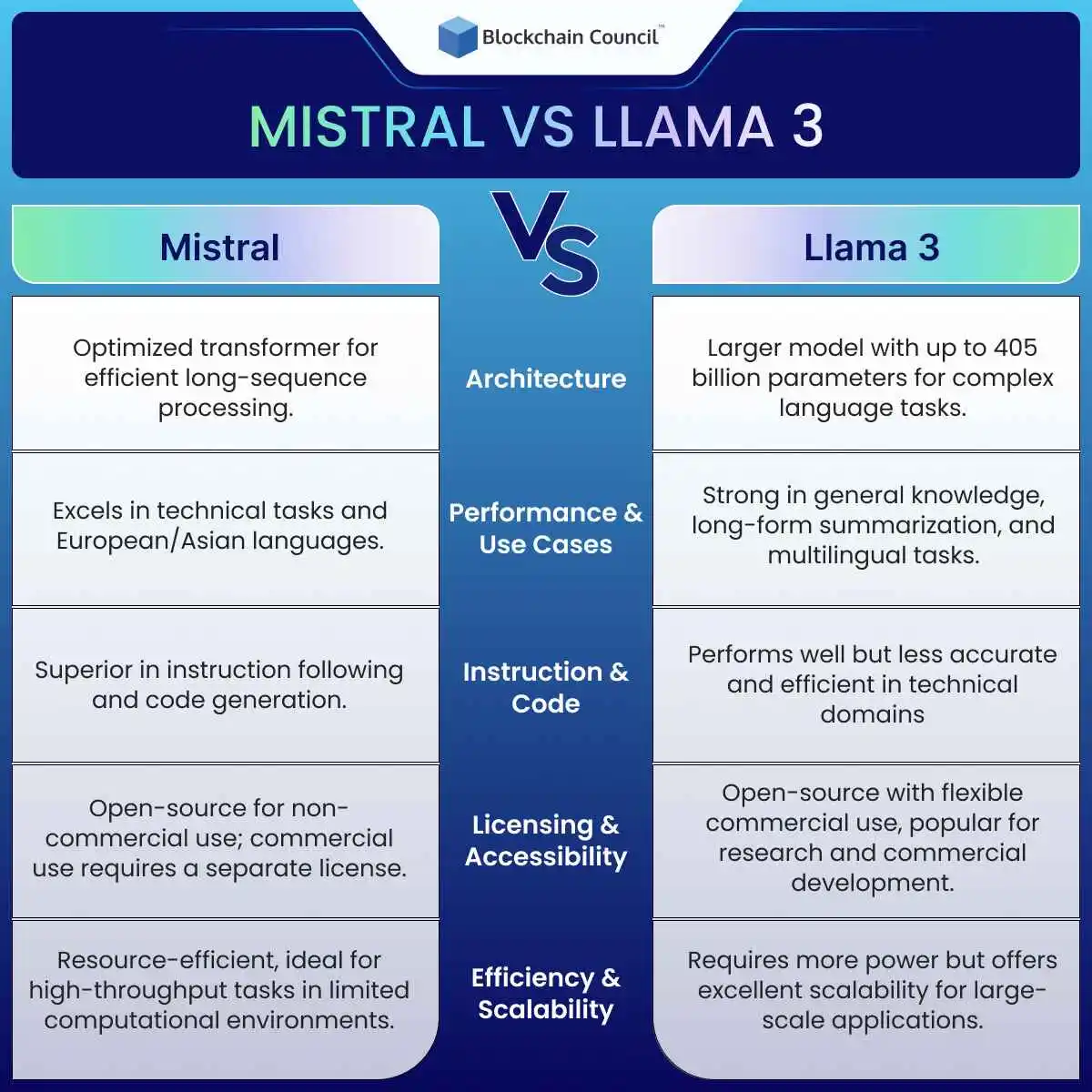
- Blockchain Council
- January 15, 2025
Language models like Mistral and Llama 3 have gained considerable attention in the AI community. Both models have made significant impacts in the field.
But who wins in Mistral Vs Llama 3?
The short answer can be Mistral, if you want a model for code generation, and Llama 3, if you want better results in multilingual applications.
But what are the key differences between the two? Read ahead to find out!
Mistral Vs Llama 3
Mistral and Llama 3 are both powerful language models made to understand and create human-like text. Mistral, developed by a Paris-based AI startup, has gained attention for its efficiency and specialization in technical tasks. Llama 3, on the other hand, is the latest in a series of models released by Meta (formerly Facebook), known for their large scale and versatility in a broad range of applications.
Let’s understand what makes these two models different:
Key Differences in Architecture
Mistral employs a transformer architecture optimized for efficiency. It uses innovations like sliding window attention and grouped-query attention, which allow it to process long sequences of text with greater efficiency and speed. These architectural choices enable Mistral to excel in tasks that require processing large volumes of data quickly, such as code generation and technical reasoning.
Llama 3, by contrast, builds upon its predecessors with a focus on scale. It offers models with up to 405 billion parameters, significantly larger than Mistral’s 123 billion. This larger size allows Llama 3 to handle more complex tasks with nuanced language understanding, making it suitable for applications like long-form text summarisation, multilingual translation, and conversational agents.
Performance and Use Cases
When comparing performance, it’s essential to consider the specific use cases each model is best suited for. Both models excel in multilingual tasks, but they have different strengths.
Mistral Large 2 has been optimised for high performance in languages like English, French, German, Japanese, and several others. Therefore, it is particularly effective in European and Asian languages. This model also handles technical domains well, such as code generation and academic research.
Llama 3.1, on the other hand, has been trained on over 15 trillion tokens. So it has a broad understanding of various languages (excels in Russian and Dutch) and tasks. It is especially good at general knowledge, long-form text summarization, and conversational tasks.
Instruction Following and Code Generation
When it comes to following instructions and generating code, Mistral takes the lead. It scores highly on benchmarks like HumanEval and MBPP, which measure how well a model can understand and execute instructions. This makes it particularly valuable for technical tasks, such as coding and debugging, where precision is crucial.
Contrary to this, while Llama 3 also performs well in these areas, it doesn’t really match the accuracy and efficiency of Mistral. This might be due to the more focused training and optimization that Mistral AI has put into its model, especially in technical domains.
Licensing and Accessibility
Another important difference lies in how these models are licensed and made accessible to users.
Mistral offers its models under an open-source license for non-commercial research. This means, developers have the freedom to access and alter the models, as long as these modifications are not intended for commercial use.. For commercial use, a separate license is required, which might limit its accessibility for some users.
Llama 3, on the other hand, is also open-source, but it offers more flexibility in commercial applications. This has made it a popular choice among developers and researchers who want to build upon the model for both research and commercial products without needing additional licensing.
Efficiency and Scalability
When it comes to efficiency, Mistral is designed to be more resource-efficient and a suitable choice for environments where computational resources are limited. It can run efficiently on a single node, which makes it practical for high-throughput tasks that demand quick processing times.
Llama 3 requires more significant computational power due to its larger size, but it compensates with greater scalability. For large-scale applications where performance and scalability are critical, Llama 3 offers robust support, particularly in scenarios involving massive datasets or complex linguistic tasks.
MT Bench and Overall Efficiency
When it comes to real-world applications, Mistral Large 2 again leads the pack. On the MT Bench, which evaluates models on their ability to generate meaningful and contextually accurate text, Mistral Large 2 scores slightly higher than Llama 3.1. This suggests that Mistral’s model can provide more relevant and detailed responses.
This can be particularly useful in technical applications and businesses where thorough explanations or comprehensive data output are required. However, this verbosity can sometimes lead to higher operational costs, especially if the task doesn’t require lengthy responses.
Conclusion
Both Mistral and Llama 3 offer significant advantages. The choice between these models ultimately depends on your specific needs. If you require a model for technical tasks or have limited computational resources, Mistral may be the better option. If your focus is on broad, multilingual applications and you have the resources to support a larger model, Llama 3 is likely the better fit.
If you want to master such AI models and use them to land a rewarding career, enrol on the globally recognized Master Artificial Intelligence (AI) Learning Path.






































































 Guides
Guides News
News Blockchain
Blockchain Cryptocurrency
& Digital Assets
Cryptocurrency
& Digital Assets Web3
Web3 Metaverse & NFTs
Metaverse & NFTs
